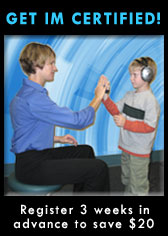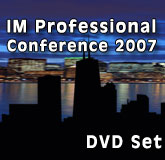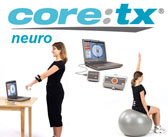|
Visit IM at the

Conference in Long Beach next week |
 |
Calling all OT's! If you are
attending the 2008 Annual AOTA Conference in Long Beach,
CA, April 10-13, we would love for you to stop by our
booth (# 322) and say "Hi". We look forward to seeing
you there.
|
 |
|
Autism Speaks |
 |
The band, Five
for Fighting, is generously donating $.49 to Autism
Speaks each time this
video is viewed. The funding goes towards
research studies to help find a cure. Please take a
moment watch the
video and pass it along. They are aiming for
10,000 hits, but hopefully we can help them surpass
this goal!
|
 |
 |
|
I made it to an IM
Certification course and it was awesome. The instructor
was absolutely amazing. I'm excited to learn more and
start using the equipment here at the clinic.
Thanks again!
IM Live Course Participant
|
|
Date |
Location |
|
4/12 |
Atlanta,
GA |
|
4/12 |
Chicago,
IL |
|
4/19 |
Ft.
Lauderdale, FL |
|
4/19 |
Spokane,
WA |
|
4/26 |
Tampa, FL |
|
4/26 |
St. Paul,
MN |
|
4/26 |
Houston,
TX |
|
5/3 |
Charlotte, NC |
|
5/3 |
Kansas
City, KS |
|
5/10 |
New
Orleans, LA |
|
5/10 |
Phoenix,
AZ |
|
5/17 |
Charleston, SC |
|
5/17 |
Port
Orchard, WA |
|
5/31 |
Naples,
FL |
|
5/31 |
Biloxi,
MS |
|
5/31 |
San
Antonio, TX |
|
6/7 |
Orlando,
FL |
|
6/7 |
Portland,
ME |
|
6/7 |
San
Diego, CA |
|
6/14 |
Indianapolis, IN |
|
6/14 |
Portland,
OR |
|
6/21 |
Toronto,
Canada |
|
6/21 |
Lincoln,
NE |
|
6/28 |
Hartford,
CT |
|
6/28 |
Birmingham, AL |
|
6/28 |
Dallas,
TX |
|
|
The cost 3 weeks
before the course date is
$205
for an individual
and $180 for a group of 3 or more.
Register Now!
Within 3 weeks of the course the regular price
is $225
for an individual
and $200 for a group of 3 or more.
*Don't see a course
in your area?
Click here to e-mail a Private Course
request (Please include 3 course dates you are
interested in.
*Note:
Courses must be scheduled at least 45 days in
advance) or call 877-994-6776 opt 4 (US Only) or
954-385-4660 opt 4
|
 |
|
SUCCESS!!! |
 |
Dear IM,
I have a success story. I began the IM training with a 5 year old
girl whom had scored in the 5% rank on the Bruininks before
treatment and after only 5 IM treatment sessions, she scored in the
42%!!!! She also taught herself how to skip and ride a stand up
scooter!!! I am amazed at how quickly this happened with her.
Thanks!An IM Provider who
is a PT
|
 |
I had to share some good news
with you. My 14 yo daughter just got a report card. In her
first marking period, she got 2 c's 1 b and 2 a's. This time
she got 4 a's and an a+. Thank you IM!!
Hope you are well!
Parent of a daughter with
Learning Disabilities
|
 |
 |
|
DVD Testimonial |
I have just
completed the IM conference DVDs which I
thoroughly enjoyed. It has caused me to
change my thinking of only using IM in the way
it was originally marketed (3-5 times per week
for 12-15 sessions). As an OT, I know that
frequency and intensity play a big role in the
degree of gains one can achieve.
Angelika
Brocklehurst OTR/L
Achievement Therapies LLC
ORDER A SET TODAY!
Cost: $160 (Includes DVD
Set) or $100 for additional CEUs (your facility must
already own the DVD set)
Contact Hours:16.0
AOTA
If you are interested in earning ASHA CEUs please
contact Bricole Plew for details at 877-994-6776 x237
Click Here to Order
Please allow 2 weeks for processing time
|
 |
 |
|
The
Core:Tx ® is versatile with 14 pre-selected
movements and the ability to add any new movements
of functional motor patterns. These exercises can be used to
facilitate neuro-muscular control and carry-over to
functional task performance while at the same time
measuring progress.
Cost: $1895 + $300 Annual
Licensing Fee
Includes: Base station,
Transceiver, USB Cable, Three AAA batteries, Six straps & one
strap extension, Software
installation CD, Core:Tx
®
user guide, &
Core:Tx
®
quick start guide.
Call 877-994-6776 to
Order today |
 |
|
IM Contact Information: |
877-994-6776 (US
only)
954-385-4660
Fax: 954-385-4674
|
|
 |
|
The following was taken from
the BestPractice/FAQ Search Engine. Look for more FAQs
in the May eNews. |
L
Low-Functioning
Q:
Can IM be used with extremely low-functioning patients?
A:
Yes,
in cases like theses hands-on assistance can be
provided.
Hands-on assistance is provided and may be required
throughout the entire IM treatment program. A near
drowning victim was confined to a wheelchair with spasticity
and paralysis. He could not access the head switch to navigate
wheelchair or access his alternative communication
device. The patient performed IM with hands-on assist.
At first 50 beats
go by before the patient could hit the trigger, now he
is down to 15
beats between hits. The patient improved from doing
nothing to navigating his own wheelchair with the head
switch, using alternative communication device and doing calculus in an on-line
program/ He has won a Chair Scholarship to University of
Florida. See
also Minimally conscious patients.
M
Marketing
Q:
Can
you suggest any marketing strategies?
A: Some marketing strategies include:
- Being listed on
the
IM Locator Board.
Note: You must own
or rent the equipment to be listed. You can update
your Locator Information
by
visiting the
Provider Login section of the website, Scroll down
the Login Home Page and click on the link that says:
"Click Here to Update your IM Treatment Types Offered "
-
Distributing IM brochures to potential clients.
These can be
purchased through IM Corp.
-
Creating Advertisements for local publications.
Access the IM logo and sample Ads on the
Provider Login.
-
Getting media coverage (live & print) from local
sources. Visit
Provider Login
for Templates.
-
Conduct a "Lunch & Learn" to educate the community
about your services. Target parents, physician
groups and support groups (Stroke, TBI, Autism, etc)
to attend.
-
Create your own website. You can use
Google to find
examples of providers who use and advertise their IM
services.
Metronome
Q:
Can
you get same outcomes with a standard metronome?
A:
A
standard metronome may encourage rhythmic movement, but does not
provide feedback for timing. When patients receive
sensory feedback, they stay engaged longer, try harder
and are encouraged to perform better. As their timing
improves, a variety of neurological domains are
affected. These include sensory,
motor, cognitive, language, and social. IM provides
feedback to improve timing and rhythm.
Military
Veterans
Q:
Is IM
used
within the Military or with Veterans?
A:
IM is in use today in the US Army and in selected VA
Hospitals to treat soldiers with amputations and blast
injuries. In addition, the Army and the VA are currently
conducting IM research with their patients.
Minimally conscious patients
Q:
Can
IM be used with minimally conscious patients?
Does it help?
A:
Yes,
IM can be used with minimally conscious patients. For
example, an
OT used IM with a patient 8 months into a minimally conscious state with
dramatic outcomes. Her patient is now in a rehab center,
awake, doing ADLs, and participating in various
therapies. She attributes her success to the Interactive
Metronome.
Music & dance training
Q:
Can
IM be used in conjunction with music & dance
instruction?
A:
Yes, IM was originally invented for use with
professional recording artists and used successfully
with them.
N
Norms
Q:
Are
there norms for the elderly population?
A:
The
IM
Indicator Table shows norms from age 6 – 60+. IM is
currently in the process of collecting data on elderly
adults in conjunction with LifeCare Centers of America,
who use the Interactive Metronome.
Q:
What
scores can be compared to the
Indicator Table? How
were IM norms obtained?
A:
IM
norms are based upon the Adjusted Average for the LFA. These
scores represent exceptional, average, and deviant
ranges of timing. We’ve learned through clinical
research and clinical application, that every movement
and thought is governed by mental timing. Theoretically,
no matter what the task is, the patient’s timing should
fall within the normal range for his/her age. Whether
you are tapping your hand on your leg or whether you are
tapping your hand on a wall, the timing of your taps
should fall within the normal range for your age. So,
you can compare timing performance of IM treatment tasks
(1-13) or ones you create on your own to the
Indicator Table. These norms were obtained by normal
subjects, ages 6 – 60+, who performed the LFA.
P
Protocols
Q:
Are
there any protocols to follow?
A:
IM
is a treatment tool that must be individualized for each
patient to achieve optimal outcomes. Protocols can be
helpful in some instances if used in a flexible manner
or if they follow a decision-tree format. At this time,
IM is not developed any protocols, just sample treatment
plans (12
Session Plan,
15 Session Plan.
Q:
What
are the 12-15 session IM treatment protocols? Are they
still used?
A:
The
12-15 session protocols are actually just sample
treatment plans. They include a disclaimer that states:
"Please note this treatment plan is an example and not
intended for use as a protocol. In addition, all
exercises are modifiable to meet individual patient
needs. For more insight into modifying IM treatment
plans, visit the “Best Practices” Section of the
Provider only website."
As a
practical matter, IM is a treatment tool, not the
treatment per se. You should always assess/monitor your
patient’s response to the IM task and settings to see if
they need further adjustment or are facilitating
progress. The six phases of IM treatment are not
new. They were included in each rendition of the IM
certification manual. We are now emphasizing the 6
treatment phases instead of the sample treatment plans
because treatment outcomes are more favorable with an
individualized approach.
Some
providers do still use the sample treatment protocols,
but find they need to modify them significantly. If
they are adhered to in a strict sense, outcomes are not
as favorable in many cases (i.e., a patient who fatigues
rapidly or exhibits cognitive impairments after stroke
may not be able to do 200-500 repetitions at a time by
the 2nd – 3rd treatment visit; a
patient who is hypersensitive to sound may not be able
to perform IM at the default volume level, he may need
it reduced. Barriers to IM treatment can be overcome by
adjusting the settings, providing cues as needed,
shorter sessions initially then longer as able, etc.
Provider milliseconds (ms) scores
Q:
What
should the providers ms scores be before using with
patients?
A:
As
low as possible, 20 ms range is ideal.
|


Blog Posting from Dr. Kevin McGrew
http://www.ticktockbraintalk.blogspot.com/
State of the
brain fitness software revolution
Brain fitness. Clearly a hot buzz phrase the past
few years. What does it mean? What is happening? Where
is it headed? Should I purchase some of the advertised
software/technology to keep my mind fresh and protected
from the influence of aging? Curious minds want to
know, and Sharp Brains has provided the most
comprehensive synthesis of the brain fitness software
field to date.
As mentioned
previously,
Sharp Brains
recently published
"State of the Brain Fitness Software Market 2008."
Before proceeding I need to mention that, IMHO, the
Sharp Brains organization is the leading
critical voice in the field of brain fitness. I've
often called them the
Ralph Nader of brain fitness. Thus, I believe
their first "state of the market" report should
receive serious attention by anyone interested in
this emerging field. It is my understanding that a
similar hardware report is in development. I can't
wait!
It is not possible to summarize the information
packed 87-paged report in a blog post, so I'll only
provide a few tidbits.
First, as stated at the Sharp Brain web page:
- The report tracks
developments at over 20 public and private
companies offering tools to assess and train
brain functions and provides important industry
data, insights and analysis to help investors,
executives, entrepreneurs, and policy makers
navigate the opportunities and risks of this
rapidly growing market. The report discusses the
implications of cognitive science on healthy
aging and a number of disorders such as
attention deficits, dyslexia, stroke and
traumatic brain injury, schizophrenia, autism,
mild cognitive impairment, and Alzheimer’s
disease. The report also provides information
and frameworks to help institutional buyers make
informed purchase decisions about brain fitness
programs.
A few (select)
highlights:
- Revenues for the
US brain fitness software market was estimated
to reach $225 million in revenues in
2007, reflecting a large increase from $100
million in 2005. Clearly the brain fitness
movement has reached and passed the
tipping point.
- Considerable
confusion exists in the market. Many products
and claims proliferate, but, according to Sharp
Brains, only five programs have demonstrated
positive cognitive effects in tightly controlled
research studies (e.g., studies that use
randomized controlled trials). Readers are
encouraged to visit the Sharp Brains web page
and blog for objective evaluations of new and
emerging brain fitness product claims.
- The consumer
brain fitness market showed significant gains
from 2005 to 2007 (from a few million in 2005 to
$80 million). Consumers should expect an
increasing array of products directly targeted
at the end-user consumer. Expect a number of new
software and technology start up companies to
join the bandwagon this year.
-
Nintendo's Brain Age and training games are
credited as being one of the major forces in the
increased interest in brain fitness.
- There are four
primary customer segments: consumers, healthcare
& insurance providers, K12 school systems, and
fortune 1000 companies, military, and sports
teams.
- Does any of this
glitzy stuff work? It depends. As is the case
with most cognitive or educational
interventions, short-term (proximal) improvement
(measured in weeks) is often demonstrated.
However, the evidence for long-term (distal)
improvement and maintenance is minimal to none,
and consists largely of circumstantial evidence.
Long-term improvement due to cognitive-based
interventions has been one of the more elusive
searches for the holy grail in the area of
intelligence.
I could go on, and on,
and on. If you are interested in capturing an
accurate picture of the state of the brain software
research and market there is only one
option, purchase their report. The report is
organized into seven chapters:
- Why now? Market
Overview
- The Science of
Brain Fitness: Neuroplasticity, Neurogenisis and
the Cognitive Reserve
- Consumers--Taking
Charge of Their Brain Health
- Healthcare and
Insurance Providers--Focus on Preventive Health
- K12 School
Systems--Responding to Learning Disabilities in
New Ways
- Fortune 1000
Companies, Military and Sports Teams--Improving
Productivity
- Future Directions:
Market trends 2007-20015.
Other brain-related
blogs have commented on this report. For example,
check out the
Brain Injury News and Information Blog.
Finally, given that I'm an educational psychologist
who has consulted on a research project (using
randomized control and treatment groups) that
demonstrated short-term (proximal) positive academic
effects for the
Interactive Metronome technology (click
here for more information and here for
conflict of interest disclosure), I was
most interested in the conclusion that the K-12
educational market "remains largely untapped due
to limited research linking cognitive training to
academic performance." I hope this changes. I
predict that there will be increased interest in the
application of brain fitness software and hardware
in the K-12 school-age market, most likely driven
first by parents purchasing products in hopes of
improving the educational performance of their
children.
|
|









